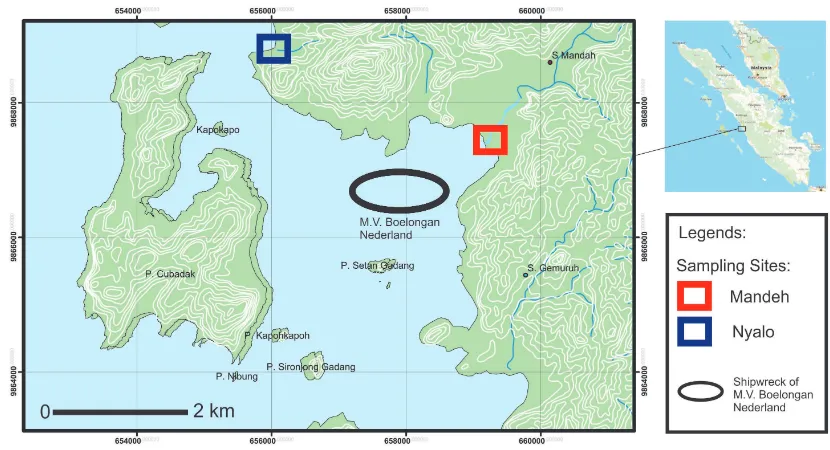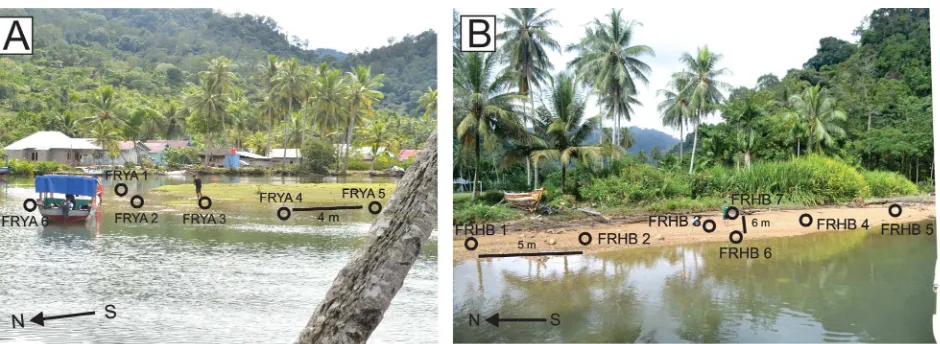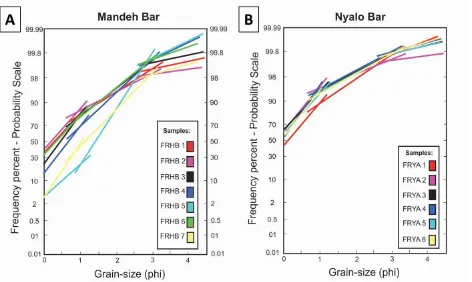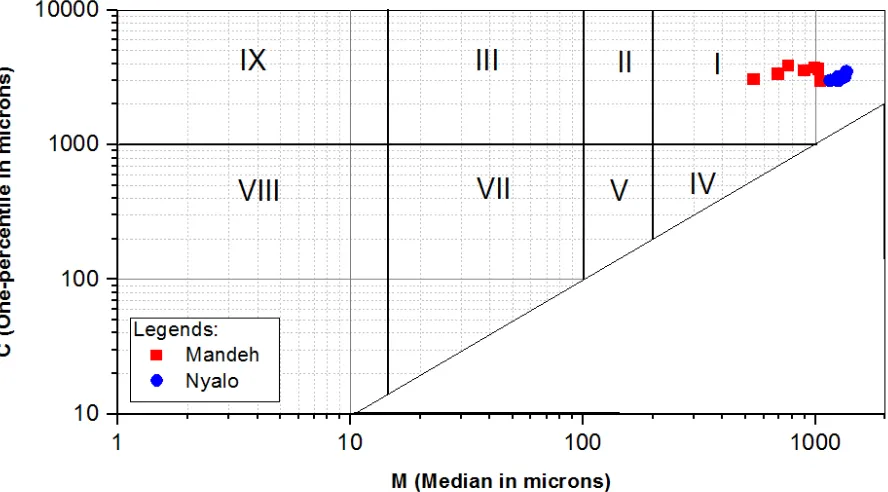Comparison of Grain-Size Profile and Depositional Process in Mandeh and
Nyalo Bar, Mandeh Bay, West Sumatera, Indonesia
Rahmadi Hidayat∗and Muhammad Fadli Rozamuri
Department of Geological Engineering, Gadjah Mada University, Yogyakarta, Indonesia
ABSTRACT. Shipwreck of MV Boelongan Nederland situated in offshore of Mandeh Bay of West Sumatera is announced as potential area for tourism destination. Many studies were produced in term of its archeological and historical side but there is no significant work in sedimentological aspect. It is critical to understand depositional process of study area regarding the design of construction to minimize the impact of dynamic activity of waves within the area. Moreover, some areas along Mandeh Bay are covered by Cubadak Island as a protection for wave action derived from Indian Ocean that can produce more complexity in depositional process and will reflect to its characteristic of grain-size pro-files. Utilizing thirteen sediment samples in two areas that correspond to inside (Mandeh Bar) and outside (Nyalo Bar) coverage of Cubadak Island, this study attempted to com-pare and contrast both grain-size profiles as well as interpretation of depositional process based on well-known analysis such as bivariate scatter plots, Linear Discriminant Func-tion plot (LDF), Log probability curves and C-M diagram. Result of this study can be integrated by other researches to gain better policy in maintaining the shipwreck conser-vation. High energy of Indian Ocean wave supported by strong current clearly dominated depositional process in Nyalo Bar with coarser grain-size; good sortation, lower Y2 of LDF plot; extremely high population of traction materials and lower range of C-M. By contrast, presence of Cubadak Island disrupted the wave effectively and created lower and fluctu-ated energy in Mandeh Bar. This phenomenon was clearly depicted in its characteristic of finer grain-size with higher Y2 value; high abundance of saltation materials and greater ratio of C-M value.
Keywords: Mandeh Bay·Grain-size analysis·Depositional process·Shipwreck conser-vation·High energy.
1 INTRODUCTION
Study area is located in downstream point-bars of Mandeh and Nyalo River within Man-deh Bay, West Sumatera Province, Indonesia (Figure 1). Mandeh Bay is being developed for new tourism destination. One of the po-tential destination is a shipwreck called MV Boelongan Nederland that has been surveyed and researched since 2006. However, most of works were related to archeological and histor-ical studies. Niaet al.(2015) attempted to make
∗Corresponding author: R. HIDAYAT, Department
of Geological Engineering, Gadjah Mada Univer-sity. Jl. Grafika 2 Yogyakarta, Indonesia. E-mail: [email protected]
major review of several studies related to the shipwreck in order to understand the degree of vulnerability against natural factors such as dy-namic of the ocean and the effect of climate.
Figure 1: Location of Mandeh Bay with sampling sites.
should be reflected to the grain-size profiles of both river bars.
This research aims to compare and contrast grasize feature characteristics as well as in-terpreted depositional process in recent sedi-ment of Mandeh and Nyalo Point-bars. Col-laborating this research with several previous study can be useful for constructing better pol-icy for maritime conservation area to be long-lasting tourism destination (Niaet al., 2015).
2 PHYSIOGRAPHY AND REGIONALGEOLOGY
According to Van Bemmelen (1949), Mandeh Bay is regionally located on physiography of Central Sumatera. In a detailed scale, it can be included as subzonation of alluvial plain along West Sumatera coastline.
Alluvium sediments are widely distributed in Mandeh Bay. Those sediments commonly have silt-size to granule-size that was deposited along coastline and downstream of rivers, in-cluding Nyalo and Mandeh. Sampling sites were focused on this area. Further landward, Oligocene--Miocene of Painan Formation is ex-posed that dominantly comprises of both epi-clastic sediment and volcaniepi-clastic complexes such lava, tuff, ignimbrite and volcanic breccia (Rosidiet al., 1996).
3 RESEARCH METHODS
Thirteen sediment samples were collected in two major point-bars along Mandeh Bay: Nyalo
(six samples, Figure 2A) and Mandeh (seven samples, Figure 2B). Applying method carried out by Lewis and McConchie (1994), samples were taken at around 5-meter intervals with rel-atively upstream-downstream as well as inside-outside bar direction. In order to maintain the quality of results, samples were taken in nat-urally preserved area away from engineering structures (Alsharhan and El-Sammak, 2004).
Pre-treatment of sediment samples was es-tablished, especially coning-quartering and re-moving organic matter. After pre-treatment, a 100-gram of each sample was sieved with a shaker for fifteen minutes through ASTM mesh 18 to 270. Wentworth (1922) was applied for grain-size classification while Folk and Ward (1957) classifications were utilized for cluster-ing sortation, skewness and kurtosis in this study. The distribution of sediment samples are depicted using statistical approaches. In previ-ous studies conducted by Sahu (1964), adopting graphical method is the most suitable in deliv-ering statistical analysis.
Figure 2: Sampling site of (A) Nyalo Bar and (B) Mandeh Bar.
4 RESULTS ANDDISCUSSION
Bivariate scatter plots
Grain-size parameters perform a basic scheme for classifying sedimentary environments. Re-cent studies often explore advanced statisti-cal techniques with several graphistatisti-cal plots (Al-sharhan and El-Sammak, 2004). Bivariate scat-ter plot comparing each of grain-size parame-ter is a viable method that widely utilized by many researchers for comparing depositional settings (Srivastava and Mankar, 2009; Rajgana-pathiet al., 2013; Martins, 2013; Jitheshkumaret al., 2015).
Griffiths (1967) explained that relationship of mean grain-size and sortation related to its hy-draulic control of sediments. Bivariate scatter plot of mean grain-size and sortation depicts significant cluster between Mandeh and Nyalo Bar Figure 3A. Nyalo Bar has coarser grain-size (-0.23 phi to -0.40 phi) and tends to have well to moderately well sorted (0.46 phi to 0.57 phi). By contrast, Mandeh Bar is distinguished by smaller particle size (-0.10 phi to 0.77 phi) and moderately sorted (0.69 phi to 0.82 phi).
Plotting of sortation against skewness can provide grouping for further sedimentary anal-ysis (Alsharhan and El-Sammak, 2004). Fig-ure 3B describes a wider range of skewness in Mandeh Bar (-0.02 to 0.46). It tends to have high variation from near symmetry to very fine skewed. By comparing to samples taken from Mandeh Bar, samples from Nyalo Bar has specifically narrow range and categorized as very fine skewed (0.41 to 0.67).
Bivariate plotting of skewness against kur-tosis corresponds to similar characteristic
be-tween both bars Figure 3C. Samples in Mandeh Bar show wider range of kurtosis (0.92 to 1.39). It is included in two groups that are mesokurtic to leptokurtic. In Nyalo Bar, the value of kurto-sis is higher and strictly lower in term of varia-tion (0.29 – 0.59).
Three bivariate scatter plots concluded major distinction of depositional processes of Nyalo compare to Mandeh Bar. Characteristic of Man-deh Point-bar indicates lower and relatively fluctuated energy. It corresponds to Cubadak Island that breaks wave energy derived from Indian Ocean to construct the sedimentation of Mandeh Bar. Compare to Nyalo Bar, wave action directly controls the depositional pro-cess without any interruptions of Cubadak Is-land. This phenomenon also reflects grain-size parameter of Nyalo Bar with typically coarser grain-size, better sortation and relatively low variation of both skewness and kurtosis.
Linear discriminant function
Figure 3: Bivariate scatter plots: (A) mean grain-size against sorting, (B) sorting against skewness and (C) skewness against kurtosis.
Moreover, these values remain consistent for grouped samples (Figure 4). Nyalo Bar com-monly comprises of lower Y2 value (23.6856 to 36.5978) than Mandeh Bar (53.6578 to 79.9753). It indicates that both bars were experienced slightly different depositional process. Lower value of Y2 suggests that depositional process of Nyalo Bar is more influenced by wave action than Mandeh Bar. As a result, the presence of Cubadak Island covering Mandeh Bar clearly disrupted the wave activity derived from In-dian Ocean. In contrary, Nyalo point-bar is rel-atively open to Indian Ocean without any dis-turbances from Cubadak Island. It allows wave action to control more dominantly.
Log probability curves
Log probability curve is a representative of cu-mulative grain-size distribution that is quite useful for clustering the sediment samples to the mode of transportation mechanism such as traction, saltation and suspension (Srivastavaet al., 2009). Visher (1969) classified the character-istic of depositional environment based on per-centage of population in transportation mech-anisms, sortation, the coarse truncation point (CT) as well as the fine truncation point (FT).
Log probability profile of Mandeh Bar de-picts saltation population in range of 19 to 50.8 % with 0.8–1 phi of CT and 2.9–3.1 phi of FT (Figure 5A). This profile is clearly dif-ferent to Nyalo Bar that commonly has maxi-mum of 12.6% of saltation population (Figure 5B). In term of suspension population, Mandeh Bar has slightly higher number (0.5 to 1.1 %) than Nyalo bar (0.1 to 0.4 %). Parameter of trac-tion populatrac-tion of Mandeh Bar is 25.1 to 82.2 % while Nyalo Bar has significantly larger value (87.3 to 92.9 %).
re-Figure 4: Linear Discriminant Function Y2- Y3plot adopted from Sahu (1964) in Mandeh and Nyalo
sediment samples.
of traction materials in similar environment cor-responds to high period of maximum current flow velocity. Based on this situation, the na-ture of Cubadak Island is effective to disinte-grate wave activities in Mandeh Bar.
C-M diagram
Advanced method in determining depositional process of sediments was developed in years. Passega (1964) stated that sedimentary deposits were formed by graded suspension when tur-bulence decreases which can be determined by a value of C (one-percentile) of grain-size pro-portional to the M (median or 50-percentile). Many sedimentologists adopted C-M diagram for defining depositional process (Natesan et al., 2012; Rajganapathi et al., 2013; Jitheshku-mar et al., 2015). Figure 6 described the result of this analysis. All samples collected in this study are included in sector I that have more typically rolled sediments (Passega and Byram-jee, 1969) rather than suspension sediments. In term of depositional environment developed by Passega (1957, 1964), both bars are suggested to fall in between beach and tractive current.
There is significant difference in M value of both bars while C value is quite similar. Nyalo Bar has M value at around 1100 microns to 1400 microns. Compared to Mandeh Bar, the size of M is much lower (500 microns to 1000 microns). This phenomenon describes a larger ratio of C-M in C-Mandeh Bar that indicates a more fluctu-ation in term of depositional process. Both bi-variate scatter plots and log probability curves also have the similar indication.
5 CONCLUSIONS
Characteristic of sediment samples collected in Nyalo and Mandeh Bar indicates significant constrast in grain-size profiles. It related to
dif-rials (87.3 to 92.9 %) as well as low ratio of C-M suggested that strong current also supports the depositional process in Nyalo Bar.
Mandeh Bar displayed a relatively contrast characteristics. It is characterized by finer grain-size (-0.10 to 0.77 phi), moderately sorted and high variability of skewness and kurto-sis. LDF depicts higher Y2 value (53.6578 to 79.9753) that indicates a significant reduction in wave activities. Moreover, high abundance of saltation (19 to 50.8 %) supports a limitation of wave action to control depositional process in Mandeh Bar. This was also strengthened by larger C-M ratio. It is interpreted that the pres-ence of Cubadak Island covering Mandeh Bar disrupted the Indian Ocean wave effectively and coincidentally produced more fluctuated energy.
ACKNOWLEDGEMENTS
The authors are grateful to LPPM team of Boe-longan as well as society in Mandeh Bay for administration processes and supporting sam-pling surface data during fieldwork.
REFERENCES
Alsharhan, A.S., and El-Sammak, A.A. (2004) Grain size analysis and characterization of Sedimen-tary Environments of the United Arab Emirates Coastal Area, Journal of Coastal Research, Vol. 20, No. 2, pp. 464–477.
Folk, R.L., and Ward, W.C. (1957) Brazos River bar, a study in the significance of grainsize parameters, Journal of Sedimentary Petrology, Vol. 27, pp. 3-26.
Griffths I.C. (1967) Scientific methods in the analysis of sediments, McGraw-Hill, New York.
en-Figure 6: C-M diagram of Mandeh and Nyalo Bar.
vironment along Ovari coast, Tamilnadu, India, International Journal of Sediment Research. Lewis, D.W., and McConchie, D.M. (1994)
Analyti-cal Sedimentology, Chapman & Hall, New York, p. 197.
Martins, L.R. (2003) Recent sediments and grain-size analysis, Gravel, Vol. 1, pp. 90-105.
Natesan, U., Deepthi, K., Muthulakshmi, A.L., Fer-rer, V.A., Narasimhan, S.V. and Venugopalan, V.P. (2012) Textural and depositional processes of sur-face sediments of Kalpakkam, Southeast Coast of India, Frontiers of Earth Science, Vol. 6, No. 4, pp. 392-404.
Nia N. H. R., Kusumah, G., Husrin, S., Kepel, T.L. (2015) Kapal karam MV Boelongan Nederland di kawasan Mandeh, lingkungan laut sekitarnya, dan kemungkinan pengembangannya, Karakter-istik Sumber Daya Laut dan Pesisir, pp. 84-133. Passega, R. (1957) Texture as characteristic of clastic
deposition. AAPG Bulletin, Vol. 41, No. 9, pp. 1952-1984.
Passega, R. (1964) Grain size representation by CM patterns as a geological tool, Journal of Sedimen-tary Research, vol. 34, no. 4, pp. 830–847.
Passega, R. and Byramjee, R. (1969) Grain size image of clastic deposits, Sedimentology, Vol. 13, No. 3-4, pp. 233-252.
Rajaganapathi, V.V., Jitheshkumar, N., Sundarajan,
M., Bhat, K.H., Velusamy, S. (2013) Grain size analysis and characterization of sedimentary en-vironment along Thiruchendur coast, Tamilnadu, India, Arabian Journal Geoscience, Vol. 6, No. 12, pp. 4717–4728.
Rosidi, H.M.D, Tjokrosaputro, and Pendowo, B. (1976) Geologic map of the Painan and Northeast-ern of the Muara Siberut Quadrangle, Sumatera, GSI.
Sahu, B. K. (1964) Depositional mechanisms from the size analysis of clastic sediments, Journal of Sedimentary Petrology, Vol. 34, No. 1, pp. 73-83. Srivastava, A. K., and Mankar, R. S. (2009) Grain
Size Analysis and Depositional Pattern of Upper Gondwana Sediments (Early Cretaceous) of Sal-bardi Area, Districts Amravati, Maharashtra and Betul, Madhya Pradesh, Journal Geological Soci-ety of India, vol. 73, pp. 393 - 406.
Van Bemmelen, R.W. (1949) The Geology of Indone-sia, vol. 1 A, Government Printing Office, The Hauge, Amsterdam.
Visher, G.S. (1969) Grain size distributions and de-positional processes, Journal of Sedimentary Re-search, Vol. 39, pp. 1074-1106.




